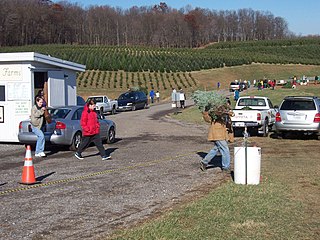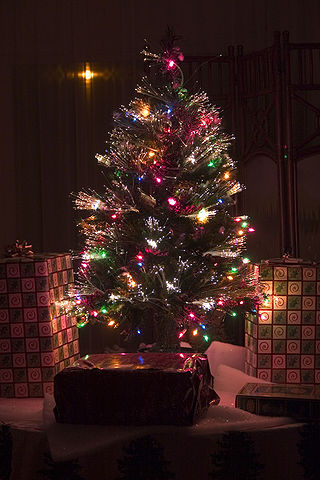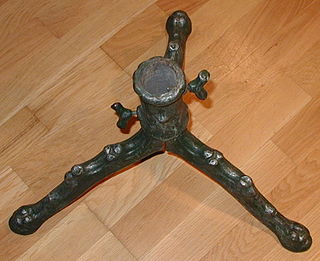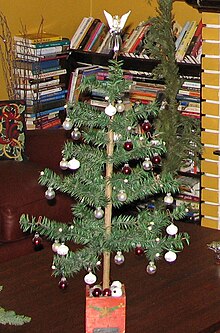
A Christmas tree is a decorated tree, usually an evergreen conifer, such as a spruce, pine or fir, or an artificial tree of similar appearance, associated with the celebration of Christmas.

Advent is a season observed in most Christian denominations as a time of expectant waiting and preparation for both the celebration of the Nativity of Christ at Christmas and the return of Christ at the Second Coming. Advent is the beginning of the liturgical year in Western Christianity. The name was adopted from Latin adventus, translating the Greek parousia from the New Testament, originally referring to the Second Coming.

Christmas lights are lights often used for decoration in celebration of Christmas, often on display throughout the Christmas season including Advent and Christmastide. The custom goes back to when Christmas trees were decorated with candles, which symbolized Christ being the light of the world. The Christmas trees were brought by Christians into their homes in early modern Germany.

Dollar Tree, Inc. is an American multi-price-point chain of discount variety stores. Headquartered in Chesapeake, Virginia, it is a Fortune 500 company and operates 15,115 stores throughout the 48 contiguous U.S. states and Canada. Its stores are supported by a nationwide logistics network of 24 distribution centers. Additionally, the company operates stores under the name of Dollar Bills, as well as a multi-price-point variety chain under the Family Dollar banner.

Christmas ornaments, baubles, globes, "Christmas bulbs", or "Christmas bubbles" are decoration items, usually to decorate Christmas trees. These decorations may be woven, blown, molded, carved from wood or expanded polystyrene, or made by other techniques.

A Christmas decoration is any of several types of ornamentation used at Christmastide and the greater holiday season. The traditional colors of Christmas are pine green (evergreen), snow white, and heart red. Gold and silver are also prevalent, as are other metallic colours. Typical images on Christmas decorations include Baby Jesus, Mother Mary, angels, Father Christmas, Santa Claus, and the star of Bethlehem. Advent wreaths, nativity scenes, illuminations, and Moravian stars are popular Christmas decorations.

Artificial plants are imitations of natural plants used for commercial or residential decoration. They are sometimes made for scientific purposes. Artificial plants vary widely from mass-produced varieties that are distinguishable from real plants by casual observation to highly detailed botanical or artistic specimens.

The White House Christmas Tree, also known as the Blue Room Christmas Tree, is the official indoor Christmas tree at the residence of the president of the United States, the White House. The first indoor Christmas tree was installed in the White House sometime in the 19th century and since 1961 the tree has had a themed motif at the discretion of the First Lady of the United States.

Weihnachten is the observance of what is commonly known in English as Christmas in the German-speaking countries such as Germany, Austria and Switzerland. It is also widespread in countries with a German-speaking minority, such as Transylvania in Romania, South Tyrol in Italy, Eupen in Belgium, and various diasporas such as the German Brazilian and German American communities. Traditions of Weihnachten influenced Advent and Christmastide culture throughout the world.

Christmas in Ireland is the annual festival which marks the Christian celebration of the birth of Jesus and its related observances, but also incorporates some pre-Christian customs. These customs range from the traditional food and drink consumed, decorations and rituals, as well as more modern phenomena such as the Christmas day swim and annual television and radio events. The modern Irish Christmas has become more similar to that of the British and American festive period, with emphasis on gift buying and parties.

Christmas tree production occurs worldwide on Christmas tree farms, in artificial tree factories and from native strands of pine and fir trees. Christmas trees, pine and fir trees purposely grown for use as a Christmas tree, are grown on plantations in many western nations, including Australia, the United Kingdom and the United States. In Australia, the industry is relatively new, and nations such as the United States, Germany and Canada are among world leaders in annual production.

An aluminum Christmas tree is a type of artificial Christmas tree that was popular in the United States from 1958 until about the mid-1960s. As its name suggests, the tree is made of aluminum, featuring foil needles and illumination from below via a rotating color wheel.

An artificial or fake Christmas tree is an artificial pine or fir tree manufactured for the specific purpose of use as a Christmas tree. The earliest artificial Christmas trees were wooden, tree-shaped pyramids or feather trees, both developed by Germans. Most modern trees are made of polyvinyl chloride (PVC) but many other types of trees have been and are available, including aluminum Christmas trees and fiber-optic illuminated Christmas trees.

A Christmas tree stand is an object designed to support a cut, natural or an artificial Christmas tree. Christmas tree stands appeared as early as 1876 and have had various designs over the years. Those stands designed for natural trees have a water-well, which, in many cases may not hold enough water to adequately supply the cut tree. Some specialty Christmas tree stands have value on the secondary antiques market.

Boone Tavern is a restaurant, hotel, and guesthouse affiliated with Berea College in Berea, Madison County, Kentucky.

A pre-lit tree is an artificial Christmas tree which is pre-wired with Christmas lights. The lights are wrapped around the tree before it is sold, reducing set up time and making storage simpler. The lights cannot usually be removed from the tree because they are normally embedded within the artificial branches. The product may be sold as a kit - the user assembles the tree and plugs it into an electrical outlet - or the dealer may assemble it before the sale. Larger trees usually contain traditional strands of bulb lights or LEDs, while smaller tabletop trees may have fiber-optic branches. Pre-lit trees are categorised under the headings of electrical goods.

The Peace Candle is a tower-like structure erected every Christmas season in Easton, Pennsylvania. The approximately 106-foot (32 m) tall structure, which resembles a giant candle, is assembled each year over the Soldiers' & Sailors' Monument, a Civil War memorial located in the city's Centre Square. It is typically assembled in mid November and lighted over Thanksgiving weekend and disassembled in early February each year.

A Singing Christmas Tree, sometimes called a Living Christmas Tree, is an artificial Christmas tree filled with singers used as part of nativity plays.

Mississippian copper plates, or plaques, are plain and repousséd plates of beaten copper crafted by peoples of the various regional expressions of the Mississippian culture between 800 and 1600 CE. They have been found as artifacts in archaeological sites in the American Midwest and Southeast. The plates, found as far afield as Florida, Georgia, Illinois, Mississippi, Oklahoma, Tennessee, and Wisconsin, were instrumental in the development of the archaeological concept known as the Southeastern Ceremonial Complex. Some of the more notable examples are representations of raptorial birds and avian-themed dancing warriors.

Rhytidiadelphus loreus, also commonly known as Lanky Moss and Little Shaggy Moss, is a nonvascular "feather moss" species that is a key component of a healthy, thriving forest ecosystem. Lanky moss grows in North America, Canada and Europe. It is primarily a coastal species that grows in moist, coniferous and deciduous forests, acidic grasslands and in the UK, heathy slopes on mountains. It grows on decaying logs, the forest floor and as an epiphyte on living trees. Its key functions in the ecosystem are water retention and temperature insulation.





















